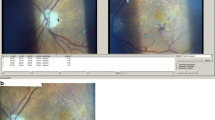Summary
Under adverse optical conditions (turbidity of the media) a well-trained observer/artist, using slit-lamp stereomicroscopy, is able to display in a drawing considerably more correct information about a fundus than what a fundus camera records. To a lesser degree this holds under favorable conditions too. General advocation of photography for being more objective is questioned; even if true, mere objectivity, i.e. no false information, would not make up for loss of important details. This paper intends to prove these points experimentally on an object (a nummulite shell) unfamiliar to the artist charged to do the drawing. The latter and photographs taken under varying conditions were compared inter se and with a high resolution scanning electron micrograph.
Zusammenfassung
Unter ungünstigen Bedingungen (trübe Medien) ist ein mit Spaltlampen-Stereomikroskopie arbeitender gut ausgebildeter wissenschaftlicher Zeichner imstande, wesentlich mehr richtige Information über einen Fundus in einer Zeichnung festzuhalten als was eine Funduskamera liefert. Bis zu einem gewissen Grade trifft das auch unter günstigen Bedingungen zu. Einer generellen Befürwortung der Photographie mit der Begründung, sie sei objektiver, kann daher nicht beigepflichtet werden; selbst wenn ihr größere Objektivität, d.h. weniger Falsch-Information, zukommen sollte, so dürfte das Verluste an wichtigen Einzelheiten kaum wettmachen. Die vorliegende Arbeit versucht diese Punkte experimentell zu stützen. Dem wissenschaftlichen Zeichner wurde ein ihm unbekanntes Objekt, eine Nummulitenschale, vorgegeben. Seine Zeichnung wurde mit nachträglich unter verschiedenen Bedingungen hergestellten Photographien sowie einer elektronenmikroskopischen Aufnahme verglichen.
Similar content being viewed by others
References
Gilbert, W. S.: Review of “The differential diagnosis of fundus conditions” by E. S. Perkins and J. H. Dobree. Trans. Amer. Acad. Opthal. Otolaryng. 77, OP-805–806 (1973)
Gombrich, E. H.: The limits of likeness, in “Art and Illusion”, 2nd ed., Bollingen Ser. XXXV. 5, Princeton: University Press 1961
Carmichael, L., Hogan, H.P., Walter, A.A.: An experimental study of the effect of language on the reproduction of visually perceived form. J. exp. Psychol. 15, 73–86 (1932)
Postman, L., Bruner, J. S., McGinnies, E.: Personal values as selective factors in perception. J. abnorm. soc. Psychol. 43, 142–154 (1948)
Bruner, J. S., Postman, L.: On the perception of incongruity: a paradigm. J. Personality 18, 206–223 (1949)
Johnson, M. L.: Seeings' believing. New Biol. 15, 60–80 (1953)
James, D. W., Johnson, M. L., Venning, P.: Testing for learnt skill in observation and evaluation of evidence. Lancet 1956 II, 379–383
Veith, N. W., Sacks, J. G.: Enumeration of small vessels on the optic disks in normal eyes. Amer. J. Ophthal. 76, 660–661 (1973)
Author information
Authors and Affiliations
Rights and permissions
About this article
Cite this article
Lotmar, W. Fundus drawings versus photography. Albrecht von Graefes Arch. Klin. Ophthalmol. 197, 39–50 (1975). https://doi.org/10.1007/BF00506639
Received:
Issue Date:
DOI: https://doi.org/10.1007/BF00506639




